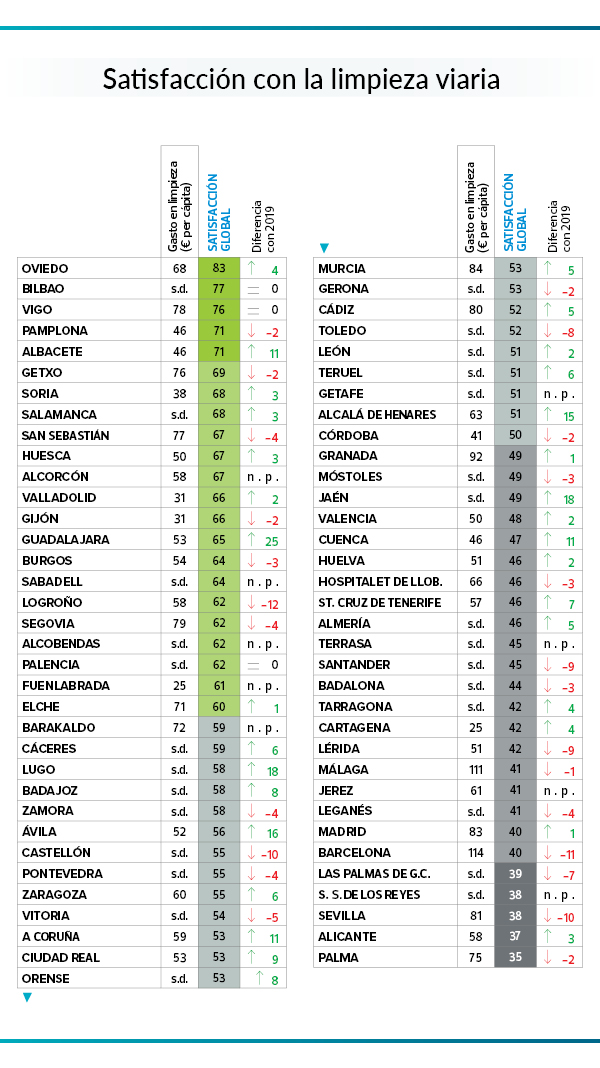 Spain’s Cleanest And Dirtiest Cities Revealed In OCU Survey
Spain News
Published: 12 June 2023 12:53 CET
Updated: 26 July 2023 12:53 CET
Spain’s Cleanest And Dirtiest Cities Revealed In OCU Survey
Spain News
Published: 12 June 2023 12:53 CET
Updated: 26 July 2023 12:53 CET
In a recent study conducted by the Organization of Consumers and Users (OCU), the cleanest and dirtiest cities in Spain have been unveiled, shedding light on the satisfaction levels of residents regarding the cleanliness of their localities. The survey, which involved nearly 7,000 participants from 69 different cities, aimed to measure the quality of life experienced in each area. The results of the 2023 survey show a slight decrease in overall satisfaction, with the average rating dropping from 53 to 52 out of 100.
Which city was rated as the cleanest?
Leading the pack in terms of cleanliness are four northern cities, with Oviedo taking the top spot. Known for its well-maintained streets, Oviedo received an impressive overall satisfaction score of 83 points. Following closely behind are Bilbao with 77 points, Vigo with 76 points, and Pamplona with 71 points.
Heading south, the cities of Albacete and Soria, located in the region of La Mancha and Castilian-Leonese respectively, also performed well in terms of cleanliness, garnering satisfaction scores of 71 and 68 points. Madrid's suburb, Alcorcón, received 67 points, while Sabadell, a city near Barcelona, scored 64 points. Rounding off the list of cities with more than 60 points is Elche, located in the eastern part of the country, with a score of 60 points.

Which were rated Spain’s dirtiest cities?
At the other end of the spectrum, the survey revealed the cities with the lowest cleanliness ratings. Palma, with a score of 35, ranked as the dirtiest city, closely followed by Alicante with 37 points, Seville with 38 points, and San Sebastián de los Reyes with 39 points. Interestingly, Barcelona, despite spending the most on cleaning expenses with 114 euros per capita, only managed to achieve a score of 40.
Malaga, another city with high cleaning expenses, allocated 111 euros per capita but ranked four places higher in terms of cleanliness. In contrast, Fuenlabrada and Cartagena recorded the lowest cleaning expenses, estimating around 25 euros per capita, with a significant disparity in their positions on the list.
Increased investment in cleaning does not always equate to higher ratings
It is important to note that higher investments in cleaning initiatives do not always guarantee better scores. This holds true for Pamplona and Albacete, two cities regarded as exceptionally clean by their residents, despite spending only 46 euros per year per resident on such endeavours. In contrast, cities like Seville, Barcelona, and Madrid allocate more than 80 euros per resident for cleaning purposes.
The survey also highlighted the changes in rankings since the previous study conducted in 2019. Guadalajara experienced the most significant improvement, climbing 25 positions, while Logroño witnessed the biggest drop, falling 12 positions.
Moreover, the responses gathered from the participants offered valuable insights into the elements that most commonly contribute to dirt and annoyance on Spanish streets. Issues such as dog excrement, graffiti, and waste around containers emerged as the top concerns among residents.
The OCU's study serves as a comprehensive assessment of the cleanliness levels in Spanish cities, providing citizens and local authorities with valuable information to improve the quality of life and environmental standards in their respective areas.
Sources
https://www.ocu.org/consumo-familia/derechos-consumidor/noticias/limpieza-ciudades
https://as.com/actualidad/sociedad/las-ciudades-mas-limpias-y-sucias-de-espana-cuales-son-n/
Data Image Credit: OCU

















